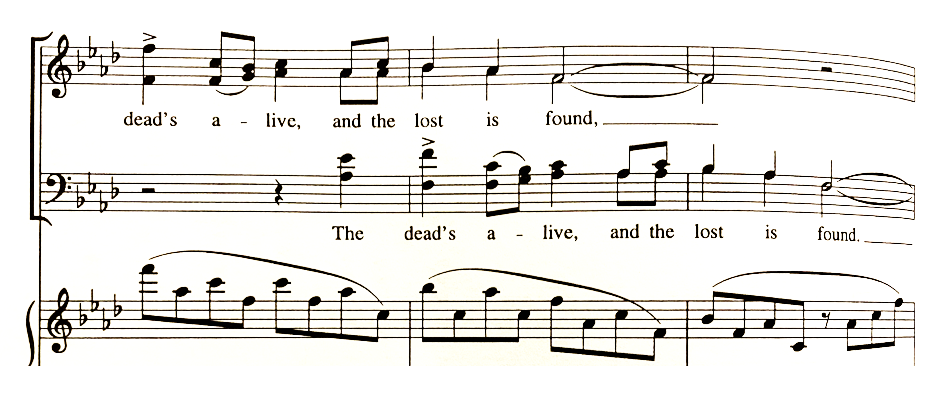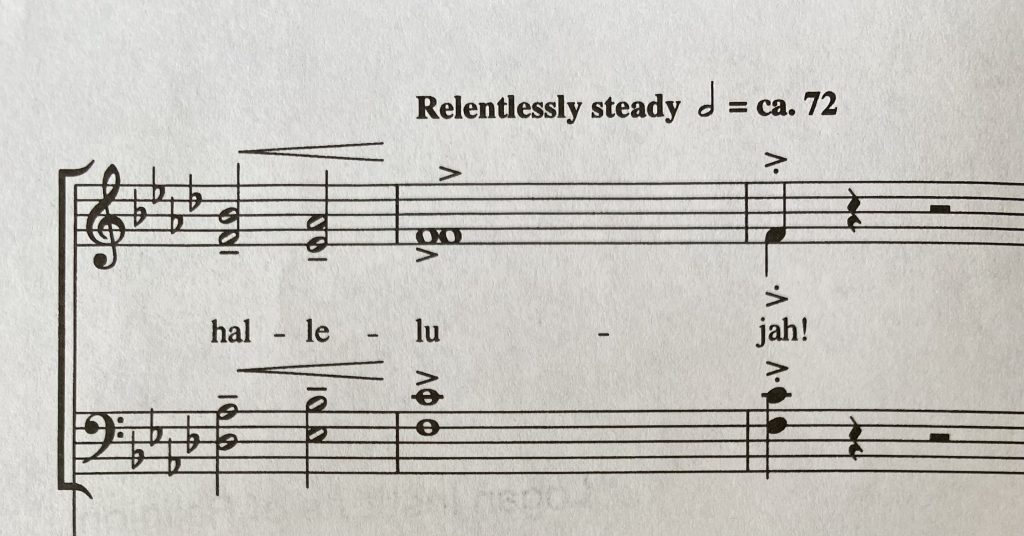“I Know That My Redeemer Lives” by Dan Forrest
Phoebe Bair
Introduction
In 1775, a former member of the Royal Navy turned Baptist minister named Samuel Medley wrote the words to the hymn I Know That My Redeemer Lives. This text has been adapted in many different ways by various Christian faith traditions and set to many tunes over the years. This arrangement, written in 2010 by Dan Forrest, uses the shape-note tune “Shout On,” written for the text in 1850 by F.C. Wood, an Alabama farmer. This tune is the only one Wood published, but remains sung today.
In Forrest’s arrangement, shape-note traditions are drawn upon and combined with modern choral compositional techniques to honor the history of the piece while also elevating it to a piece that is engaging to modern listeners.
Overview
This piece follows the verse-refrain structure that is seen in the original hymn. This piece uses the basic framework of the original hymn (the melody and text) and many harmonic elements of shape-note singing. However, the original song is expanded by adding transitional interludes that play off of the refrain while adding layered rhythms and countermelodies. Although the piece repeats the same core melody, it builds in complexity throughout each verse. Additionally, while shape-note hymns were traditionally unaccompanied, this particular arrangement adds a complex piano accompaniment for four hands.

Text: https://sacredharpbremen.org/277-antioch/
Analysis
Text
The text, taken from a hymn written in the eighteenth century by Baptist minister Samuel Medley, shows a clear verse-refrain pattern. It contains short verses, each two lines long, separated by a two-line refrain. Each line of the hymn ends with “Glory, hallelujah,” making the text very repetitive throughout. The text is written in iambic tetrameter, which is generally reflected in the melody, where stressed syllables closely align with the song’s important beats. This arrangement generally stays true to the original text, with an added interlude after the second and third verses where part of the refrain is repeated. It is worth noting that this text has been edited many times, with several more recent versions (including the arrangement in the LDS hymnbook) omitting the refrain and combining the short two-line verses into longer, four-line verses.
Form
The verse-refrain pattern structure seen in the text is echoed in the form of the piece. There is a slow, a capella introduction, after which it moves to a verse/refrain pattern that is repeated throughout the piece. An interlude/transition, which expands on the material of the refrain, separates verses two and three, with a similar interlude following the third verse. The piece concludes with a brief coda. For a visual of each of these elements, refer to the form diagram in the overview above.
Rhythm and Meter
This piece is written in cut time, with a quick tempo (other than in the introduction section). There is a strong, percussive pulse felt throughout. The rhythm is taken from a shape-note melody written by F.C. Wood, a farmer in Alabama. Because the original melody was written to be easy to read for churchgoers without formal musical training, it is not very rhythmically complex. However, this arrangement builds in complexity as the piece progresses. The second verse introduces some syncopation and countermelodies in the inner voices (see example below) and a canon between the treble and bass lines in the refrain. The interlude similarly plays on old material but uses syncopation and overlapping melodies.

This example shows how the arranger added syncopated interjections into the middle voices to add complexity to the second verse.
Texture
Because this piece is taken from a traditional Western hymn, it centers around a homorhythmic texture. It becomes more texturally dense throughout with what could be considered melody and accompaniment, bordering on polyphony in some spots where the countermelody is clearer. The piano accompaniment, which is written for four hands and maintains an eighth note pulse for the majority of the piece, also adds to this dense melody/accompaniment texture. The example below shows a canon between the upper and lower voices in the second refrain as the texture becomes more dense.

Harmony
The piece, which starts in F minor, uses the chords expected out of a traditional hymn melody written in the nineteenth century. No accidentals are seen in the piece. During the interlude between the second and third verse, the piece modulates to G minor. Harmonically, there are many elements that are borrowed from shape-note tradition, such as the open fifths and fourths usually written in parallel. The melody of the piece uses a minor pentatonic scale, also very common among shape-note hymns.

However, several harmonic elements feel more modern- most of the chords are written in root position, and the arpeggiating accompaniment means that the thirds of chords are generally not omitted. Although the melody is in a pentatonic scale, Forrest’s piano accompaniment is not. Both of these harmonic elements are more typical of modern choral music. Unlike shape-note hymns, this piece sets the melody in the soprano rather than the tenor line, making it easier to hear for modern listeners. There are multiple VII – i or VI – VII – i cadences at the ends of phrases.

Teaching
Since this piece uses a minor pentatonic scale, which may be new to many choral students, it offers an opportunity to explain how this scale is built. A brief overview of pentatonic scales could be used as an introduction to this piece, along with warmups utilizing F minor pentatonic. This would also be an easy scale to have students practice improvisation or composition. Pentatonic scales work well for building confidence in these skills as there aren’t “wrong notes” in the same way that diatonic improvisations may be perceived.
To focus on the rhythm and also history of the music, a conductor could also show videos (such as this one from a shape-note convention in Ireland) and explain how these songs were led and conducted. The choir could recreate this atmosphere, having students take turns “leading” the rest of the choir. This would also help the students feel the cut time pulse in the piece.
Rehearsal
This piece is fairly straightforward, but there are a few sections that may be challenging. Some of the syncopation in the second verse, refrain, and transition may be areas where the overlapping rhythms could be isolated without pitch to solidify the syncopation and make sure the rhythms stay sharp. The quick tempo may also feel overwhelming to less experienced readers, so beginning at a slow tempo while maintaining the steady pulse and marcato feel will help. Making sure performers feel confident in their parts will be essential to achieve the style specified by the arranger.
Performance
The author notes in the piece that choirs should “always sing marcato (non legato), and feel ‘in 1’ by emphasizing downbeats.” The tempo marking also describes the piece as “relentlessly steady.” Because of these notes, the conductor should have little variance in the tempo (other than in the introduction and coda), and should make sure that the first beat is accented throughout. Due to the repetitiveness of the material, having an arc throughout stylistically through dynamics that complements the complexity that builds in the texture will keep the piece engaging. One of the key moments in the piece is in measures 78-80, where the piano accompaniment stops and the choir returns to a homophonic texture (other than the soprano descant), standing in contrast to the dense section before. This section should be emphasized and be one of the strongest moments in the piece in terms of dynamics and articulation.

